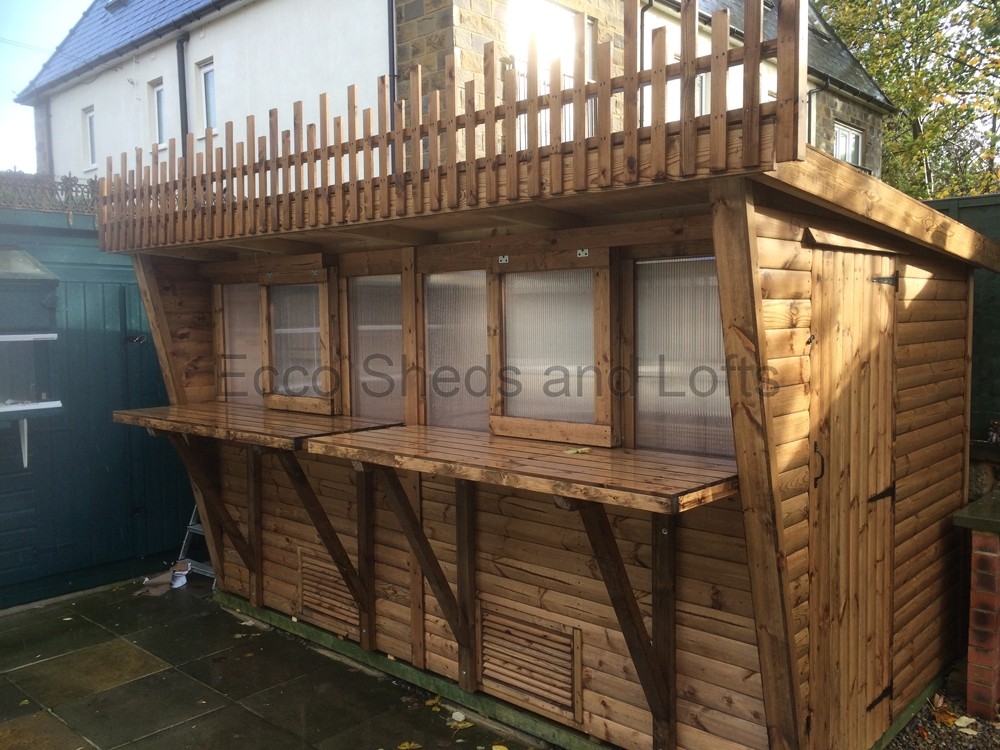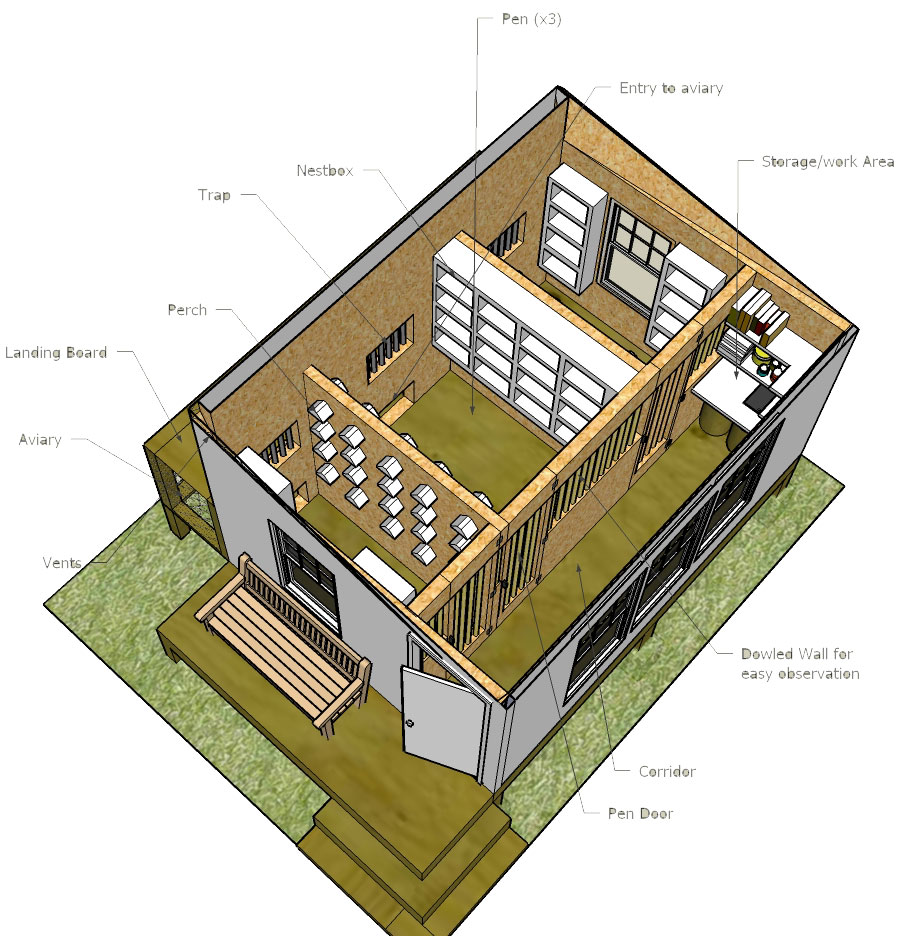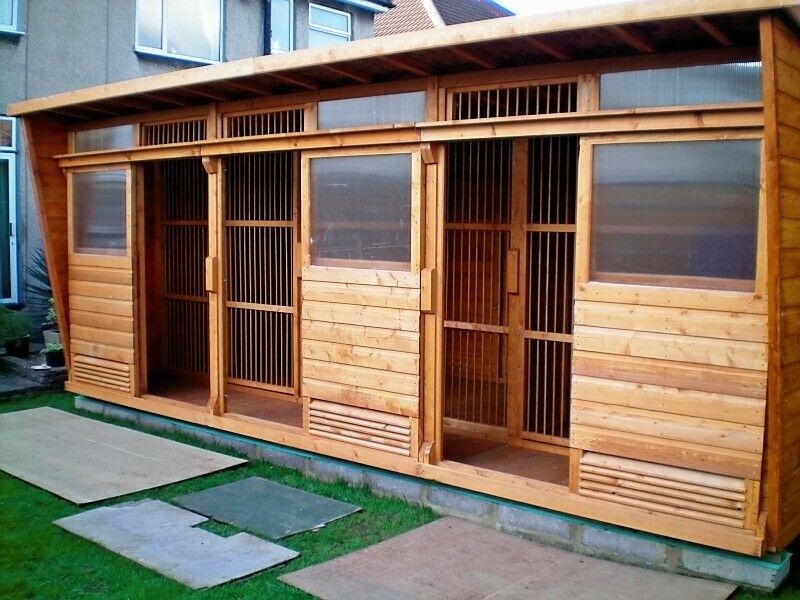Loft Tips
Posted by Tom Fremont, Midnight Blue Lofts.
TIP #1
Do not overcrowd. Pigeons need room and plenty of it. They need their space, and their marked territory to feel secure, and stress free. If they constantly have to fight and defend their space because of overcrowding, then you will have stressful, unhappy, and sick pigeons. I’ve seen 4 x 8 sections with 60 pigeons residing within. Are you kidding me ? There is only so much oxygen to go around. Exhaled oxygen forms a poisonous Carbonic Acid Gas. This gas coupled with the Ammonia released from large accumulations of pigeon droppings create a very toxic atmosphere within the loft. It brings on stress and respiratory problems. I’ve heard many a fancier say that “deep litter’ (another way of saying I prefer not to clean my loft) … yes, that deep litter if dry does not harm the pigeon. This is nonsense. “Deep Litter” does not start out dry, it has to go through a process to dry, and be assured that during that long process ammonia is omitted into your loft air !! The greatest fanciers the world has ever known ‘The Janssen Brothers of Arendonk’ meticulously cleaned their lofts 2 or 3 times daily. They vacuumed the dust out weekly. They formed and created the greatest strain in Racing Pigeon History. I for one am going to trust their practice of maintaining a clean loft.
TIP #2
Ventilation. This is a very misunderstood concept. There probably is not a ‘perfect’ ventilation system for any loft. However there are very smart ways to keep your loft full of fresh air, without the dreaded drafts on you pigeons. (especially at night). Bring in the cooler fresher air in from the lower parts of your loft through vents. At the peaks of your roofline allow for the stale air to pass through, thus creating a constant flow of fresh air. (I use small fans at the roof vents most of the year to make sure there is an air flow). This also keeps the loft cooler during extreme heat. As long as your pigeons are not in the direct path of your airflow you should not have problems.
TIP #3
Sunlight. Pigeons need it all…. They need and crave the sun for all the goodness it has to offer (very similar to humans) However they do not need constant sun either. (similar to humans) I can only scratch my head when I see a loft without aviaries. It is such a simple concept that is ignored by so many fanciers. I want the aviaries filled with as much sun as possible throughout the day. I want my aviaries facing South if at all possible. My second choice would be West. My pigeons ‘hang out’ in the aviaries for hours on end, why? Because they crave the sun and fresh air. They NEED the sun and fresh air. If you are too busy or flat out too lazy to build aviaries, then I can’t help you. Build some nice spacious aviaries, and enjoy your healthy pigeons.
TIP #4
Variety. Pigeons get bored. Yes you read that correctly, pigeons get bored. (Just like keeping a dog in a kennel all day long, they get bored and go stir crazy if they don’t get out).
As mentioned above, aviaries give them another place to go, another place to explore. The nest boxes should be a nice size and a place where they can move with some freedom, a place they can be comfortable in. Perches should be abundant and strategically located in the loft. Give the pigeons some choices and variety within the loft. At night they will always go to their favorite perch, but during the day let them move around and explore. I like to create ‘nooks and crannies’ within the loft. Different places and angles within the structure to keep them exploring and interested. Pigeons are very curious creatures by nature. They are extremely smart, and each one possesses his or her own unique personality. It is very beneficial to get to know your pigeons, understand their personality and what makes them tick. Then on Race Day it is very easy to motivate them. This is one of the great advantages to having a small loft, and a small amount of pigeons. It stands to reason that it is far easier to get to know in-depth each of your 14 racers, as opposed to working with 100 racers. (A TIP within a TIP) this will not cost you any extra 🙂 Did you know that most male birds of any origin do NOT like to perch near their nest. When the hen is on her nest the cock likes to perch from a distance. Why ? He instinctively does not like to draw attention to where his hen and eggs are located. He likes to watch over his nest and territory from a distance. I always try to have perches set up across the loft for the cocks to roost on and view their nest territory. They simply are not comfortable if they have to perch right at their nest.
TIP #5
Structure. Here I’m only going to cover the basics, and common sense concepts. If possible face your loft towards the South. Again, second choice would be to face it West. When you build, elevate your loft about 16 inches off the ground. The airflow will keep the loft dry, and aid in proper ventilation. Use strong thick plywood for your base floor. (I double lay my floor for added strength and stability) Double walls with a few inches of air space in between is very important. (this helps keep the loft cool in the summer and warm in the winter). Make sure your roof line has a valid pitch, whether it be an A-frame or a slanted roof. I like a false ceiling with air holes, then above the false ceiling you locate your vents at the peaks. Again, small fans to blow out the vents are very helpful for good ventilation. Frame your openings to the aviaries large enough for the birds to easily fly through without damaging their wing tips. This also allows for good sun flow into the loft to dry and warm the floors. If you need more sun flow, then South or West windows work well. Also many good fanciers utilize skylights for extra light and sun.
I like a strong and well tiled roof. I like an exaggerated overhang as well. In a hard rain you want your loft to remain dry. If your loft is leaking you are going to have problems. A wet loft will bring on poor health very quickly.
TIP #6
High and Dry. If possible build your loft on higher ground. Build your loft away from trees and wires if possible. Keep away from wet or swampy areas if possible. ‘High and Dry will keep the bugs and other varmints away, (not completely, but it will help) In Europe many of the lofts are 2nd story or attic lofts. Keeping the loft filled with fresh air, proper sunlight, and as dry as possible will go a long way to keep your pigeons healthy.
REMEMBER a happy pigeon is a healthy pigeon. Pigeons are not machines or robuts. You do not just plug them in on race day and expect great results. They are complex and intricate creatures that will perform like crazy given the proper care and attention. There are fanciers who keep hundreds of pigeons in dreaded conditions, who send as many as they can on race day, and hope something hits. Honestly I have very little time for this method. True pigeon Masters are on a very different level than this. You simply do not have to race 100 pigeons to obtain success. (I want to make one clarification here, there are fanciers who race with 100 pigeons that DO give them all the care, room and proper attention they need) However there are far more who don’t. Like they say “If the shoe fits wear it”
Next month we are going to dive deeply into the concepts and tips for health. Without health, you will always be on the losing end.
An added note for this first writing … as you can sense, I’m going to say it like it is, and in no way do I intend to offend anyone. These concepts and principles that I’m going to lay out have stood the test of time for both myself and many fanciers across the globe. My number one intention for the reader is to help you avoid the many pitfalls that we may face as fanciers.



